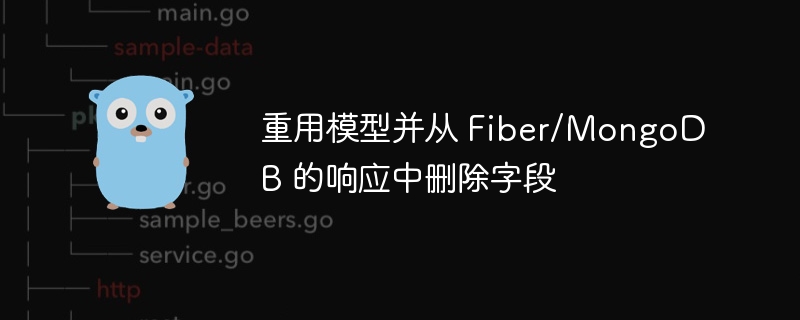

In this article, php editor Zimo will introduce how to delete fields and reuse models in Fiber/MongoDB responses. When we get data from the database, sometimes we need to delete some fields to meet specific needs or to protect sensitive information. Fiber/MongoDB is a popular PHP framework that allows you to quickly build high-performance web applications. In this article, we will learn how to improve the reusability and maintainability of your code by using the power of Fiber/MongoDB to remove fields and reuse models in your application.
I'm trying not to create code walls and not redeclare code when it's not needed.
My two main questions now are:
In line 47, the existing user model userCollection.FindOne(ctx, filter, opts).Decode(&user) is overwritten/decoded, but it is not updated, line 46 The options in are not applied unless I declare var user2 = models.User and decode to user2 on line 47, then return user2
Line 46 has opts := options.FindOne().SetProjection(bson.M{"password": 0}). If I use the second user user2 from the example above, it returns the password in the JSON response but it is empty. Is it possible to completely remove the password key from the response without creating another user model just to use it in the response?
func CreateUser(c *fiber.Ctx) error {
ctx, cancel := context.WithTimeout(context.Background(), 10*time.Second)
defer cancel()
var user models.User
//validate the request body
if err := c.BodyParser(&user); err != nil {
return c.Status(http.StatusBadRequest).JSON(responses.UserResponse{Status: http.StatusBadRequest, Message: "error", Data: &fiber.Map{"data": err.Error()}})
}
//use the validator library to validate required fields
if validationErr := validate.Struct(&user); validationErr != nil {
return c.Status(http.StatusBadRequest).JSON(responses.UserResponse{Status: http.StatusBadRequest, Message: "error", Data: &fiber.Map{"data": validationErr.Error()}})
}
var email = &user.Email
count, err := userCollection.CountDocuments(ctx, bson.M{"email": email})
if err != nil {
return c.Status(http.StatusBadRequest).JSON(responses.UserResponse{Status: http.StatusBadRequest, Message: "error", Data: &fiber.Map{"data": "Something went wrong"}})
}
if count > 0 {
return c.Status(http.StatusBadRequest).JSON(responses.UserResponse{Status: http.StatusBadRequest, Message: "error", Data: &fiber.Map{"data": "Email already in use"}})
}
//set the status, hash password, set activate token and updated at
status := 0
password := hashPassword(*user.Password)
activateToken := uuid.New().String()
updatedAt, _ := time.Parse(time.RFC3339, time.Now().Format(time.RFC3339))
//create user object
user.ID = primitive.NewObjectID()
user.Password = &password
user.Status = &status
user.ResetToken = &activateToken
user.CreatedAt = updatedAt
user.UpdatedAt = updatedAt
result, err := userCollection.InsertOne(ctx, user)
if err != nil {
return c.Status(http.StatusInternalServerError).JSON(responses.UserResponse{Status: http.StatusInternalServerError, Message: "error", Data: &fiber.Map{"data": err.Error()}})
}
//get created user from the DB and cast it into UserResponse model
filter := bson.M{"_id": result.InsertedID}
opts := options.FindOne().SetProjection(bson.M{"password": 0})
userCollection.FindOne(ctx, filter, opts).Decode(&user)
//return created user
return c.Status(http.StatusOK).JSON(responses.UserResponse{Status: http.StatusOK, Message: "success", Data: &fiber.Map{"data": user}})
}
I have tried creating a separate model UserResponse without the password field and declaring the second User model in the CreateUser function to be able to view the output of FindOne with the options in the response.
After a few hours of figuring it out and posting it here, I had a brilliant moment.
All the changes made here is to redeclare the user as an empty user model:
user = models.User{} // <- the fix
filter := bson.M{"_id": result.InsertedID}
opts := options.FindOne().SetProjection(bson.M{"password": 0})
userCollection.FindOne(ctx, filter, opts).Decode(&user)
The above is the detailed content of Reuse models and remove fields from responses in Fiber/MongoDB. For more information, please follow other related articles on the PHP Chinese website!
 python packaged into executable file
python packaged into executable file
 How to install third-party libraries in sublime
How to install third-party libraries in sublime
 Introduction to article tag attributes
Introduction to article tag attributes
 How to set transparency in CSS
How to set transparency in CSS
 How to use python for loop
How to use python for loop
 How to use cloud storage
How to use cloud storage
 How to modify folder 777 permissions
How to modify folder 777 permissions
 How to solve the problem that the device manager cannot be opened
How to solve the problem that the device manager cannot be opened




